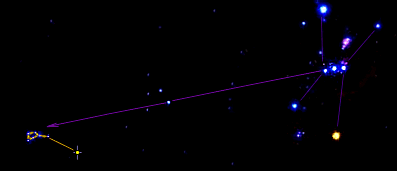
Those that are of Orion is the apparent meaning of the term Nephilim from Genesis 6:4of the New English Bible. Masonic researchers Christopher Knight and Robert Lomas claim that the root Aramaic word nephîliâ is one name for the constellation. The Nephilim, of course, are familiar to readers of Zecharia Sitchin. This prolific scholar translates the Sumerian root NFL (not the American football league!) as “...those who were cast down upon the Earth!” The King James version calls them “giants in the earth.” Just before the great flood “the sons of the gods,” interpreted as either fallen angels or the Watchers, mated with “the daughters of men” to produce these giants. It may be more than a coincidence that Nephilim sounds much like the Hebrew word nemâlâh, which means ant. In this case, morphology rather than size is the primary factor.
If the Nephilim are indeed “of Orion,” the Ant People could actually be those who were cast down from the skies, perhaps from Orion itself.
Because the constellation rises due east, one might think that the name Orion was derived from the word orient. In actuality, it is formed by dropping the initial "m" in the Indo-European stem morui. Astoundingly, this word means ant. Perhaps the constellation was so named because its narrow, anthropomorphic waist suggests the insect.
The Hopi term for Orion is Hotòmqam, which literally means either “to string up” (as beads on a string) or “trey.” This could refer to the three stars of Orion’s belt but also to the tripartite form of the ant: head, thorax, and abdomen. These shiny, bead-like sections of the ant’s body may have their celestial counterpart in what the Hopi consider the most important constellation in the heavens. The appearance of Orion through the overhead hatchways of Hopi kivas (semi-subterranean prayer chambers) still synchronizes many annual sacred ceremonies
When Orion dominates winter skies, the ants are deep in their own “kivas” (hills). Although this seems contradictory, the zenith and the nadir are actually one shamanistic axis comprising the Underworld. Two separate realms exist in the Hopi cosmology: the surface of the earth as the site of human activity and a combined sky/underground region as the home of the spirits, in particular the kachinas. (For the Hopi a kachina is a masked spirit that can assume the form of any physical object, phenomenon, or living being.)
Both the ant mound with its dark tunnels and the kiva with its sipapuni (a hole in the floor symbolically linking it to the Underworld) embody the nether plane. This paradoxically arches upward across the skies to serve as home to the star spirits.
The Hopi god of death, the earth, and the Underworld is named Masau’u. Like the ants, he possesses knowledge of both the surface of the earth and the chthonic regions. He wears a mask with large open eye-holes and a large mouth. His huge, bald head resembles a summer squash, and his forehead bulges out in a ridge. His feet are long as a forearm, and his body is gray. This color is essential, since his name comes from the Hopi word maasi, meaning gray. In fact, this description from Hopi mythology is uncomfortably close to contemporary images of extraterrestrial Greys.
Masau’u is also the terrestrial equivalent of Orion, whose name, as we said, means ant. The Hopi believe that distances are insignificant to Masau’u because he can traverse the entire earth before morning comes. What better way to express Orion’s movement from the eastern to the western horizon during the night?
The Hopi word for ant is anu. In the same language naki means friend, prayer feathers, food offerings, or sand--a nexus of concepts pertaining to this insect that sometimes flies. A combination of the two words (anu-naki, or “ant friend”) may be related to Sitchin’s Anunnaki. The Babylonian sky god was also named Anu. One Sumerian cylinder seal from around 2250 B.C. shows the pantheon of primary deities wearing peaked hats. The Hopi sky god Sotuknang, closely associated with the earth god Masau’u, also wears a pointed headdress. Like their Middle Eastern counterparts, these American Indian divinities were present at the creation of the universe and continued to be instrumental in the culture’s development.
Anu (or Danu) was also the appellation of the Celtic mother goddess and patroness of the dead. In addition, Anu was another name for the Egyptian city of Heliopolis, where the benben stone of meteoric iron was kept. Furthermore, the Egyptian word anu meant not only products, revenues, or something brought in but also gifts, tributes, and offerings. This refers to both the ants’ ability to store provisions and the reverence given to the Ant People. In any case, their influence is global.


